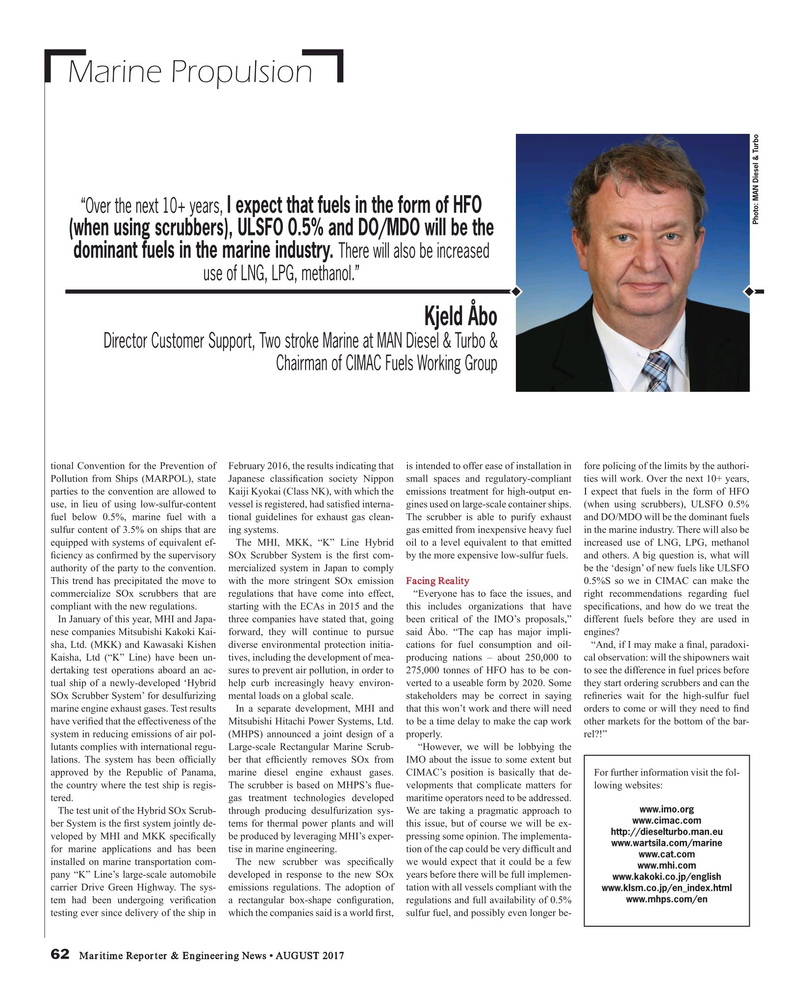
Page 62: of Maritime Reporter Magazine (August 2017)
The Shipyard Edition
Read this page in Pdf, Flash or Html5 edition of August 2017 Maritime Reporter Magazine
Marine Propulsion “Over the next 10+ years, I expect that fuels in the form of HFO
Photo: MAN Diesel & Turbo (when using scrubbers), ULSFO 0.5% and DO/MDO will be the
There will also be increased dominant fuels in the marine industry. use of LNG, LPG, methanol.”
Kjeld Åbo
Director Customer Support, Two stroke Marine at MAN Diesel & Turbo &
Chairman of CIMAC Fuels Working Group tional Convention for the Prevention of February 2016, the results indicating that is intended to offer ease of installation in fore policing of the limits by the authori-
Pollution from Ships (MARPOL), state Japanese classi? cation society Nippon small spaces and regulatory-compliant ties will work. Over the next 10+ years, parties to the convention are allowed to Kaiji Kyokai (Class NK), with which the emissions treatment for high-output en- I expect that fuels in the form of HFO use, in lieu of using low-sulfur-content vessel is registered, had satis? ed interna- gines used on large-scale container ships. (when using scrubbers), ULSFO 0.5% fuel below 0.5%, marine fuel with a tional guidelines for exhaust gas clean- The scrubber is able to purify exhaust and DO/MDO will be the dominant fuels sulfur content of 3.5% on ships that are ing systems. gas emitted from inexpensive heavy fuel in the marine industry. There will also be equipped with systems of equivalent ef- The MHI, MKK, “K” Line Hybrid oil to a level equivalent to that emitted increased use of LNG, LPG, methanol ? ciency as con? rmed by the supervisory SOx Scrubber System is the ? rst com- by the more expensive low-sulfur fuels. and others. A big question is, what will authority of the party to the convention. mercialized system in Japan to comply be the ‘design’ of new fuels like ULSFO
This trend has precipitated the move to with the more stringent SOx emission Facing Reality 0.5%S so we in CIMAC can make the commercialize SOx scrubbers that are regulations that have come into effect, “Everyone has to face the issues, and right recommendations regarding fuel compliant with the new regulations. starting with the ECAs in 2015 and the this includes organizations that have speci? cations, and how do we treat the
In January of this year, MHI and Japa- three companies have stated that, going been critical of the IMO’s proposals,” different fuels before they are used in nese companies Mitsubishi Kakoki Kai- forward, they will continue to pursue said Åbo. “The cap has major impli- engines?
sha, Ltd. (MKK) and Kawasaki Kishen diverse environmental protection initia- cations for fuel consumption and oil- “And, if I may make a ? nal, paradoxi-
Kaisha, Ltd (“K” Line) have been un- tives, including the development of mea- producing nations – about 250,000 to cal observation: will the shipowners wait dertaking test operations aboard an ac- sures to prevent air pollution, in order to 275,000 tonnes of HFO has to be con- to see the difference in fuel prices before tual ship of a newly-developed ‘Hybrid help curb increasingly heavy environ- verted to a useable form by 2020. Some they start ordering scrubbers and can the
SOx Scrubber System’ for desulfurizing mental loads on a global scale. stakeholders may be correct in saying re? neries wait for the high-sulfur fuel marine engine exhaust gases. Test results In a separate development, MHI and that this won’t work and there will need orders to come or will they need to ? nd have veri? ed that the effectiveness of the Mitsubishi Hitachi Power Systems, Ltd. to be a time delay to make the cap work other markets for the bottom of the bar- system in reducing emissions of air pol- (MHPS) announced a joint design of a properly. rel?!” lutants complies with international regu- Large-scale Rectangular Marine Scrub- “However, we will be lobbying the lations. The system has been of? cially ber that ef? ciently removes SOx from IMO about the issue to some extent but approved by the Republic of Panama, marine diesel engine exhaust gases. CIMAC’s position is basically that de- For further information visit the fol- the country where the test ship is regis- The scrubber is based on MHPS’s ? ue- velopments that complicate matters for lowing websites: tered. gas treatment technologies developed maritime operators need to be addressed. www.imo.org
The test unit of the Hybrid SOx Scrub- through producing desulfurization sys- We are taking a pragmatic approach to www.cimac.com ber System is the ? rst system jointly de- tems for thermal power plants and will this issue, but of course we will be ex- http://dieselturbo.man.eu veloped by MHI and MKK speci? cally be produced by leveraging MHI’s exper- pressing some opinion. The implementa- www.wartsila.com/marine for marine applications and has been tise in marine engineering. tion of the cap could be very dif? cult and www.cat.com installed on marine transportation com- The new scrubber was speci? cally we would expect that it could be a few www.mhi.com pany “K” Line’s large-scale automobile developed in response to the new SOx years before there will be full implemen- www.kakoki.co.jp/english carrier Drive Green Highway. The sys- emissions regulations. The adoption of tation with all vessels compliant with the www.klsm.co.jp/en_index.html www.mhps.com/en tem had been undergoing veri? cation a rectangular box-shape con? guration, regulations and full availability of 0.5% testing ever since delivery of the ship in which the companies said is a world ? rst, sulfur fuel, and possibly even longer be- 62 Maritime Reporter & Engineering News • AUGUST 2017
MR #8 (58-65).indd 62 MR #8 (58-65).indd 62 8/7/2017 2:37:11 PM8/7/2017 2:37:11 PM

 61
61

 63
63
